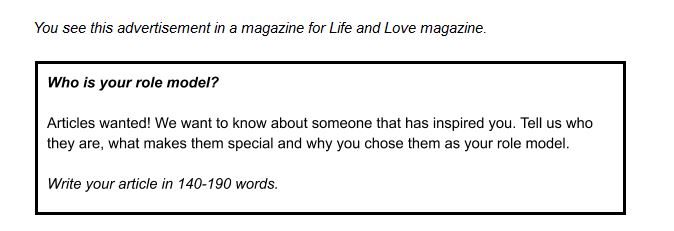Escribir un artículo es parte muy importante del writing tanto en nivel B1 como B2. No siguen características muy diferentes, pero en este articulo las definiremos según los niveles.
An article can be read in magazines, newspappers and even in blogs, they gives us information, guides and opinions on specific topics, and it’s main objetive is to take the reader attetion until the end of it.
Now I am going to explain how to create an article from an example:

The structure
Paragraph 1: Introduction: Start with a catchy opening line to hook the readers.
There is not one who could be as an amazing person as/such as my grandfather and granny. Their strong personality and vitality have marked me for my life, because they are the person who have been next to me all my life.
Paragraph 2: Describe the topic giving examples and developing your answer.
For a start I will tell you how was their teen ages. The used to lived in a small village in the middle of the mountaint in Ronda, they went to school, where they learnt how to write and read and basic things for their dailylife. My grandfather remembered those times with so much love, he always told us that his best friend at that time was a goat, which always went with him to school and he always tell us how their school mates usually played with it on the playgound. My granny used to go to school too but she also was taught how to sew and cook since she was a girl, that’s why he is the best cooker, I love her food. She also used to work in her family’s backery at that time. Bouth of them were the youngest one in the family so they were very spoyled.
When the grow up, my grandparents got merry, that’s when they moved to Ronda city, while my granny was pregnat with my father. They lived there for a few moth before moved to Algeciras with some of their simblids and my grandfather’s mother.
After they moved to Algeciras my father had another two siblinds, and my grandfather opened in the market an inlay shop. In a start all the family was living together but while time past, they moved to another house, until my grandfather bought a house on a flat in the city center. I am the first great-doughter in the family so I have spent do much time with them. Every weeken I used to go to mass on Saturday and we visited their other relatives, who lived near an ice cream shop and in summer I always had one each tiem we went to see them. Also, I used to cook with my granny or even sew. It was very funny and unforgatefull.
Paragraph 3: This should be like a conclusion and give the reader a lasting comment or a question to think about.
On top of that they are my modal rolle since they have been taking care of all the family all this time. Since they are the youngest in the family they have seen eveyone died, they have taken care of all those who were left alone. When I have been on my worst they have always been there, but not only for me, just for everyone who needed them. They are the strongest people that I know, and now a days they are having a really hard time because of the covi-19 situation since they cannot see the family as much as they would like too. They have lived so much and have tought me how to afort all those hard times. They have given me a life lesson.
Who is your life lesson? in which way have him/her/it influenced you?
For to divided those paragraph you can divede them using diferent connectors like:
First paragraph: For a start…
Second paragraph: Not to mention…
Third paragraph: On top of that…
These ones are examples but you can use whatever you want or you are used to use.
Tips
Think about the question.
It could be a family member that you look up to or a person in the community who’s done something amazing.
Think about the tone.
They are between semi-formal and informal tone. They are informative and entertaining.
Think about what is the best structure.
Even I have given you a basic structure it can be different depending on the topic or what you want to express, but always have on mind that it must be logical, coherent and msut include different ideas in different paragraphs.
Think about the vocabulary.
You can d a braindstorming wiht ideas and vocabulary that can help you to be more creative.
Personalise your writing.
You can give to your writing a personal style like adressing the reader with pronouns like «you, I»
Have you ever wondered…?
I’m sure you can imagine…
Can you believe…?
I will never forget…
There’s nothing more amazing than…
If you ask me…
B1 Evaluation 2020:
at least 100 words
You included everything in the question
You’ve used a variety of sentence lengths
Correct Present, Past, Perfect, Future and Modal verbs use; superlatives and comparatives, gerund, conditionals, passive voice en present, past and perfect, relatives, correct adjetives, etc.
The spelling is correct
It’s personal and engaging
You haven’t repeated the same vocabulary too often
It’s not too formal
B2 Evaluation 2020:
Between 140 to 190 words
You included everything in the question
You’ve used a variety of sentence lengths
Correct Present, Past, Perfect, Future and Modal verbs use; superlatives and comparatives, gerund, conditionals, passive voice en present, past and perfect, modal causative, relatives, correct adjetives, etc.
The spelling is correct
It’s personal and engaging
You haven’t repeated the same vocabulary too often
It’s not too formal
Credits: https://oxfordhousebcn.com/
